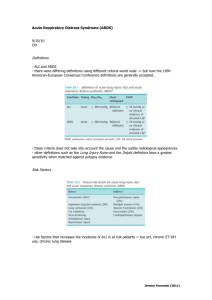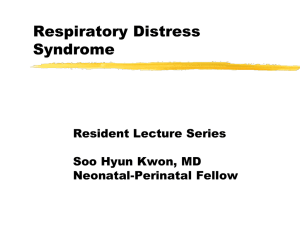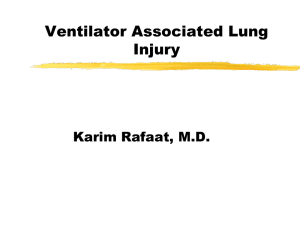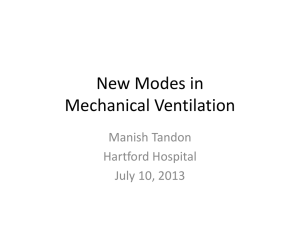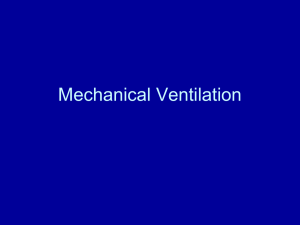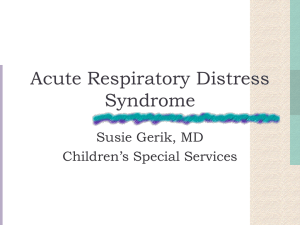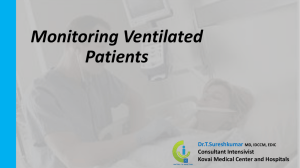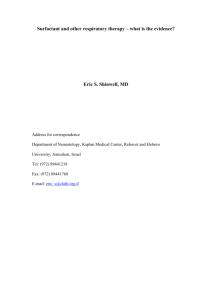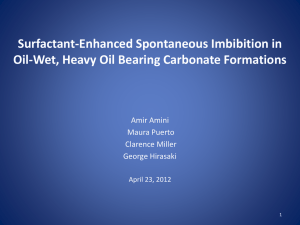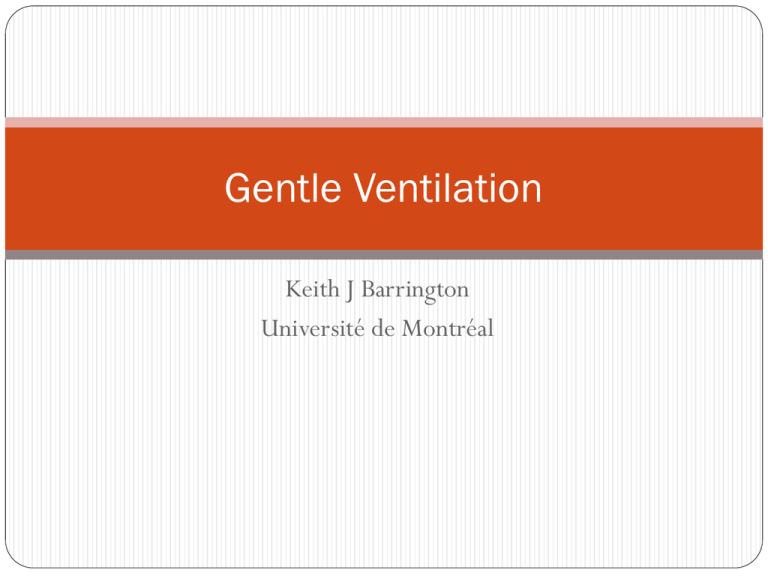
Gentle Ventilation
Keith J Barrington
Université de Montréal
Gentle Ventilation
We all want to do it… but what is it?
Outline:
Avoiding ventilator induced lung injury
Permissive Hypercapnia
Early extubation and non-invasive ventilation
Lung Injury
What is it that damages the lungs during assisted ventilation?
Over-Distension
Atelectasis
Intubation
Infection
Avoiding Lung Injury
Reducing over-distension
Optimal PEEP
Optimal tidal volume
Preventing atelectasis
Intubation only when required
Preventing Lung infection
Over-distension
Over-distension much more important than too much
pressure
Very high pressures have little adverse effect if overdistension
is prevented.
Several animal studies showing that vey high pressures cause
little damage if the chest wall is restricted, and tidal volumes
remain acceptable
How to determine over-distension?
Reducing over-distension
Are ventilator graphics useful?
I am not aware of any reliable data that shows that they are
useful in reducing lung injury
Why not?
Leaks
Dynamic not Static
Change from breath to breath
Pressure-volume loops.
Donn S M , Sinha S K Arch Dis Child Fetal Neonatal Ed 2006;91:F226-F230
Pressure-volume loops. (A) The loop shows hyperinflation, with an upper inflection point on the inspiratory limb. (B) The loop
has been normalised by reducing the peak inspiratory pressure. Vt, Tidal volume; Paw, peak airways pressure.
Copyright © BMJ Publishing Group Ltd & Royal College of Paediatrics and Child Health. All rights reserved.
Overdistension
Because of leaks and variable baselines, ventilator graphics
reset to zero at end-expiration.
The shape of the loops changes with every breath (unless the
baby is paralyzed)
Therefore there is no way to determine what the endexpiratory lung volume is, or even whether it has changed!
Dynamic compliance does not change after surfactant
administration
Compliance, surfactant and loops
The usual effect of giving surfactant is an improvement of
STATIC lung compliance (which can only be measured in a
non-breathing patient in whom you take PEEP down to 0)
If static compliance is improved: at the same PEEP endexpiratory lung volume is higher
This shifts the lung up the pressure-volume curve, and the
end-inspiratory portion is on a flatter part of the curve
Effects of Surfactant on Dynamic
Compliance
Surfactant
Control
Before
After
Before
After
Compliance (ml/cm H20/kg)
0.43 _+ 0.21
0.45 _+ 0.45
0.33 _+ 0.14
0.33 ___ 0.13
Resistance (cm H20/L/sec)
141 _+ 90
175 _+ 97
160 _+ 90
173 + 98
Tidal volume (ml/kg)
6.3 _+ 1.7
5.3 _+ 1.5
6.9 _+ 2.1
6.0 + 1.9
Table II. Combined pulmonary mechanics data
Values are expressed as mean _+ SD.
Immediately before and 1 hour after
Couser, R., T. Ferrara, et al. (1990). "Effects of exogenous surfactant therapy on dynamic compliance
during mechanical breathing in preterm infants with hyaline membrane disease." The Journal of
Pediatrics 116(1): 119-124.
Static
Compliance
Stenson, B. J., R. M.
Glover, et al.
(1994). "Static
respiratory
compliance in the
newborn. III: Early
changes after
exogenous
surfactant
treatment." Arch
Dis Child Fetal
Neonatal Ed 70(1):
F19-24.
This means that you cannot use the pulmonary graphics to
determine whether the PEEP is optimal or if the baby is ready to
wean
A better way to determine whether the surfactant has had an
effect is simply to watch the FiO2
When the FiO2 falls, reduce the PEEP: you will immediately
afterward see the pip fall (on volume ventilation) or the volume
increase (on pressure ventilation)
Infants who reduce to 21% after surfactant can be managed with a
reduction in PEEP to 3 cmH2O
Dimitriou, G., A. Greenough, et al. (1999). "Appropriate positive end
expiratory pressure level in surfactant-treated preterm infants." Eur J Pediatr
158: 888-891.
Reducing Overdistension
Preventing overdistension requires
Preventing end-expiratory lung volumes from being too high
Preventing tidal volumes from being too high
Preventing Atelectasis
Requires adequate PEEP
varies by patient, depending on static compliance
Adequate tidal volume
Less variable but pressures required very variable
What is the right tidal volume?
Probably between 3 and 6 mL/kg
Normal physiologicVt lies between 3 and 8 mL/kg
Ventilator Parameters
Volume ventilation mode (VGV or volume control)
4 to 5 mL/kg (or 4 mL/kg plus 0.5 mL for the ETT)
If in more than 21% O2: PEEP of 5 to 8 before surfactant,
increase PEEP to keep FiO2 less than 60%
Surfactant as early as possible
After surfactant reduce PEEP to 4 if in 21% O2, if remains in
21% reduce to 3, if remains in 21%, WEAN.
A potential useful application of ventilator graphics
Ventilator paramteres
What are you going to wean, and what are you going to
monitor?
If on an SIMV mode, wean rate, but if your ventilator gives
PSV then you are switching to pressure ventilation….
If on an A/C mode watch pressures and spontaneous rate,
reduce the back up rate progressively (maybe) and extubate
when the pip is below a certain thershold.
What to do about CO2?
Permissive hypercapnia
Increasing ventilation to normalize a CO2 risks increasing
lung injury for questionable benefit
Permissive hypercapnia does not mean forcing the CO2 to
increase!!
It means not chasing the CO2 if the tidal volume is OK, the
FiO2 is OK and the baby is clinically OK
It means being prepared to wean the vent if all those factors
are OK, even in the face of elevated CO2
But is there a limit?
Respiratory acidosis is good for you!
Despite numerous concerns about the effects of CO2 there is little
evidence that an elevated CO2 has permanent adverse effects
There is some evidence of short term benefit in the critically ill.
1.
Chonghaile MN, Higgins BD, Costello J, Laffey JG: Hypercapnic
acidosis attenuates lung injury induced by established bacterial
pneumonia. Anesthesiology 2008, 109(5):837-848.
2.
Costello J, Higgins B, Contreras M, Chonghaile MN, Hassett P, O'Toole D,
Laffey JG: Hypercapnic acidosis attenuates shock and lung injury in
early and prolonged systemic sepsis. Critical care medicine 2009,
37(8):2412-2420.
3.
O'Toole D, Hassett P, Contreras M, Higgins BD, McKeown ST, McAuley DF,
O'Brien T, Laffey JG: Hypercapnic acidosis attenuates pulmonary
epithelial wound repair by an NF-kappaB dependent mechanism.
Thorax 2009, 64(11):976-982.
High Frequency Ventilation?
Early extubation
Removing the tube as fast as appropriate
Or not intubating if you can avoid it
Self-evident that never being ventilated is better than being
ventilated (BPD does occur in never intubated babies, but
only mild forms)
But if you need surfactant: the sooner the better, even an
hour of delay makes a difference
The challenge to identify quickly infants who will need
surfactant
Improving the success of early
extubation
Caffeine
Non-invasive ventilation
Intermittent positive pressure ventilation by non-invasive
means has been studied in the preterm newborn
Synchronized nIPPV decreases the frequency of extubation
failure in the VLBW
The only method to synchronize (the infantstar capsule) is no
longer available.
A new method (NAVA) is probably capable to synchronize,
but not yet tested in preterms
Studies of non-synchronized IPPV are needed
Synchronization?
1 RCT of non-synchronized nIPPV published (Kumar et al
2011) but the controls did not get CPAP (already proven to
reduce extubation failure)
RCT of nIPPV vs CPAP after early
surfactant and extubation
Ramanathan R J Perinatol 2012 (non-synchronized)
RCT of early nIPPV vs CPAP
Kishore M et al, Acta Paediatrica 2009
Initial mode of ventilatory support or after surfactant
Fewer re-intubations with nIPPV
Summary
Avoidance of intubation if possible
Careful attention to optimal PEEP
Limitation of tidal volumes
Early extubation to nIPPV with caffeine
When used in carefully protocolized fashion
Will reduce lung injury in preterm infants.

